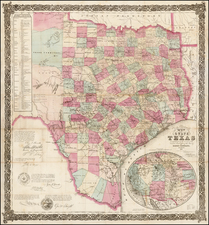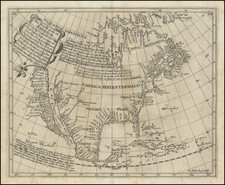The Most Influential Cartographic Representation of North America in Globe Gore Format, from Coronelli's Celebrated 42 inch Terrestrial Globe.
Decorative set of globe gores, forming the whole of North America, from Coronelli's 42 inch Terrestrial Globe.
The present set of gores provides a remarkable large format depiction of North America, based upon the monumental terrestrial globe constructed by Coronelli for Louis XIV. The gores are virtually identical to the content of Coronelli's 2 sheet map of North America, with the exception of the elaborate explanatory text in the text block at the top left corner. The vast majority of the vignettes are virtually identical.
While the most striking feature of the map is the depiction of California as an island, historically, it is Coronelli's treatment of the Rio Grande that is of greatest significance. Earlier map makers had consistently shown the river flowing into the Gulf of California. While Giovanni Battista Nicolosi was the first to properly show the course of the Rio Grande flowing into the Gulf of Mexico, it was not until Coronelli adopted this treatment of the river that it received universal acceptance. One of the annotations in the map adjacent to Il Paeso (El Paso) notes that the course of the river has historically been depicted as flowing southwest, but is correctly shown now flowing northeast.
In describing Coronelli's map of North America, Burden refers to it as "a major leap in the cartography of the day. . . " Cartographically, Coronelli's depiction of the Great Lakes is the most advanced to date, drawing on information from the explorations of Louis Jolliet and Jacques Marquette. The Mississippi basin reflects the French discoveries of René-Robert Cavelier, and Sieur de La Salle on his first expedition of 1679-82. This map depicts La Salle's misplacement of the mouth of the Mississippi, which he located some 600 miles to the west of its true location.
In the West, Coronelli's map contributes a significant amount of new information, drawn mostly from the manuscript map drawn by Diego Dionisio de Peñalosa Briceño y Berdugo, which included numerous previously unrecorded place names and divided the Rio Grande into the Rio Norte and the Rio Bravo in the south. The manuscript map was prepared by Peñalosa between 1671 and 1687, as part of his attempts to interest the French King Louis XIV, in a military expedition against New Spain.
The map is richly illustrated with a number of geographical vignettes and a number of annotations in Italian, including one noting the discovery of the region by the Spanish in 1598 and several other dated annotations, referencing early travels in the region. The cartouche in the Pacific Ocean refers to the debate over California's insularity and references the explorers Cortez, Ulloa, Alarcon and Cabrillo in the region. Offshore, a reference to Nuno Guzman's coastal exploration along the coast of Mexico in 1532, is given. The cartography of the gore is very similar to Coronelli's 2 sheet map of North America, which appeared in his Atlante Veneto, and there is some question as to which was published first.
Vincenzo Coronelli apprenticed as a Xylographer before joining the Convental Franciscans in 1665. In about 1678, after studying Astronomy and Euclid, Coronelli began working as a geographer and was commissioned to make a set of Terrestrial and Celestial Globes Ranuccio II Farnese, for the Duke of Parma, which were 5 feet in diameter. Coronelli was next invited to Rome to construct a similar pair of Globes for Louis XIV. From 1681 to 1683, Coronelli lived in Paris where he constructed a pair of 10 foot diameter globes for the King at a weight of nearly 4000 pounds.
The fame and importance of Coronelli's globe led to the production of a 42 inch diameter globe in 1688, for which complete of examples reside in a number of major institutional collections around the world. Separate globe gore sheets from this famous globe periodically appear on the market. Coronelli worked for a number of years as a Geographer and Theologian, before returning to Venice in 1705, where he published his Atlante Veneto and founded the Accademia Cosmografica degli Argonauti.
Individual Coronelli Gores are rare on the market. This set of globe gores is an exceptional artifact, offered in a stylistically unique presentation.
Vincenzo Maria Coronelli (1650-1718) was one of the most influential Italian mapmakers and was known especially for his globes and atlases. The son of a tailor, Vincenzo was apprenticed to a xylographer (a wood block engraver) at a young age. At fifteen he became a novice in a Franciscan monastery. At sixteen he published his first book, the first of 140 publications he would write in his lifetime. The order recognized his intellectual ability and saw him educated in Venice and Rome. He earned a doctorate in theology, but also studied astronomy. By the late 1670s, he was working on geography and was commissioned to create a set of globes for the Duke of Parma. These globes were five feet in diameter. The Parma globes led to Coronelli being named theologian to the Duke and receiving a bigger commission, this one from Louis XIV of France. Coronelli moved to Paris for two years to construct the King’s huge globes, which are 12.5 feet in diameter and weigh 2 tons.
The globes for the French King led to a craze for Coronelli’s work and he traveled Europe making globes for the ultra-elite. By 1705, he had returned to Venice. There, he founded the first geographical society, the Accademia Cosmografica degli Argonauti and was named Cosmographer of the Republic of Venice. He died in 1718.









![[ Early United States Map ] Carte Des Etats-Unis De L'Amerique Septentrionale, dresse d'apres des Cartes Anglaises…](https://storage.googleapis.com/raremaps/img/small/39783.jpg)
![[ Catholic Dioceses and Missions in the United States ] Karte der katholischen Dioecesen und der en Missionen in Nordamerika nach den nuesten geographischen Angaben... 1845](https://storage.googleapis.com/raremaps/img/small/98630.jpg)
![[Imperial & Coachella Valley Advertising Map -- Valerie Jean Date Shop]](https://storage.googleapis.com/raremaps/img/small/69651.jpg)


![[ Cook's Discoveries in Russian America ] Chart of the NW Coast of America and the NE Coast of Asia explored in the Years 1778 & 1779 . . .](https://storage.googleapis.com/raremaps/img/small/68831.jpg)